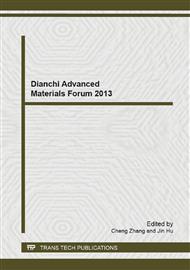[1]
M. Winter, R. J. Brodd, What are batteries, fuel cells, and supercapacitors? Chem. Rev. 104 (2004) 4245–4269.
DOI: 10.1021/cr020730k
Google Scholar
[2]
J. Claude, Y. Y. Lu, Q. Wang, Effect of molecular weight on the dielectric breakdown strength of ferroelectric poly(vinylidene fluoride-chlorotrifluoroethylene)s, Appl. Phys. Lett. 91 (2007) 212904.
DOI: 10.1063/1.2816327
Google Scholar
[3]
Z. C. Zhang, T. C. M. Chung, The Structure-property relationship of Poly(vinylidene difluoride)- based polymers with energy storage and loss under applied electric fields. Macromolecules. 40 (2007) 9391-9397.
DOI: 10.1021/ma071561e
Google Scholar
[4]
Y. Kobayashi, T. Tanase, T. Tabata, T. Miwa, M. Konno, Fabrication and dielectric properties of the BaTiO3–polymer nano-composite thin films. J. Eur. Ceram. Soc. 28 (2008) 117–122.
DOI: 10.1016/j.jeurceramsoc.2007.05.007
Google Scholar
[5]
J. Kulek, I. Szafraniak, B. Hilczer, M. Polomska, Dielectric and pyroelectric response of PVDF loaded with BaTiO3 obtained by mechanosynthesis, J. Non-Cryst. Solids. 353 (2007) 4448–4452.
DOI: 10.1016/j.jnoncrysol.2007.02.077
Google Scholar
[6]
Y. Y. Lu, J. Claude, Luis Enrique Norena-Franco, Q. Wang, Structural dependence of phase transition and dielectric relaxation in ferroelectric Poly(vinylidene fluoride-chlorotrifluoroethylene- trifluoroethylene)s, J. Phys. Chem. B 112(2008).
DOI: 10.1021/jp802413g
Google Scholar
[7]
Z. M. Li, Y. H. Wang, Z. Y. Cheng, Electromechanical properties of poly(vinylidene-fluoride chlorotrifluoroethylene) copolymer, Appl. Phys. Lett. 88 (2006) 062904.
DOI: 10.1063/1.2170425
Google Scholar
[8]
L. Nedelcu, A. Ioachim, M. Toacsan, M. G. Banciu, I. Pasuk, C. Berbecaru, H. V. Alexandru, Synthesis and dielectric characterization of Ba0. 6Sr0. 4TiO3 ferroelectric ceramics, Thin Solid Films 519 (2011) 5811–5815.
DOI: 10.1016/j.tsf.2010.12.191
Google Scholar
[9]
W. M. Xia, Z. Xu, F. Wen, Z. Z. Zhang, Electrical energy density and dielectric properties of poly(vinylidene fluoride-chlorotrifluoroethylene)/BaSrTiO3 nanocomposites, Ceramics International 38 (2012) 1071–1075.
DOI: 10.1016/j.ceramint.2011.08.033
Google Scholar
[10]
X. Zhou, B. J. Chu, B. Neese, M. Lin, Q. M. Zhang, Electrical energy density and discharge characteristics of a poly(vinylidene fluoride-chlorotrifluoroethylene) Copolymer, IEEE Trans. Dielect. Elect. Insul. 14 (2007) 1133–1138.
DOI: 10.1109/tdei.2007.4339472
Google Scholar
[11]
X. L. Dou, X. L. Liu, Y. Zhang, H. Feng, J. F. Chen, S. Du, Improved dielectric strength of barium titanate-polyvinylidene fluoride nanocomposite, Appl. Phys. Lett. 95 (2009) 132904.
DOI: 10.1063/1.3242004
Google Scholar
[12]
B. J. Chu, X. Zhou, B. Neese, Q. M. Zhang, Relaxor ferroelectric poly(vinylidene fluoride- trifluoroethylene- chlorofluoroethylene) terpolymer for high energy density, Storage Capacitors, IEEE Trans. Dielect. Elect. Insul. 13 (2006) 1162–1169.
DOI: 10.1109/tdei.2006.247845
Google Scholar


